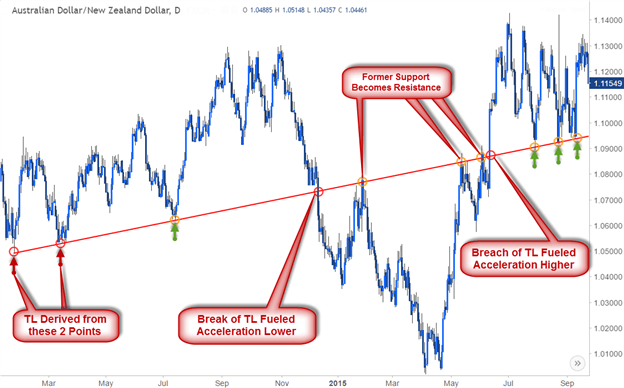[ad_1]
Reviewed by Nick Cawley on August 5, 2022
In this series we will piece together the anatomy of a swing trade and discuss the tools along with the methodology used to construct a basic trade setup. While no one single strategy is perfect, these best practices can be utilized in conjunction with your own trading strategy to identify more favorable entry / exit points in trending market environments.
Trendlines are the simplest and single most important (and largely underutilized) tool in your trading arsenal. Extending a line off key highs & lows in price is an objective way of assessing the gradient or slope of a trending market. This key step can help identify where the price is likely to find support (floor) or resistance (ceiling).
DXY Daily Price Chart
Note that trendline analysis can be viewed as more of an art form than a science as it requires some form of subjectivity. That said, when drawing trendlines, the more touch points the market has, the stronger conviction the slope offers. This means that the reaction off the trendline (slope) becomes increasingly effective.
In the example of the U.S. Dollar Index, the positive slope casts a bullish outlook, with the broad game plan to buy as price trends higher. So where should our entry point be? A pullback into trendline support would be the most favorable entry
With the same respect, a break often offers sharper and more significant reversals. Once a trendline support is broken, the slope now becomes resistance for prices, and often foreshadows a change in market behavior. This slope can now be seen as a reference of invalidation for the current move lower.
AUD/NZD Daily Price Chart
Likewise, a breach above a trendline resistance sees that line as support for the subsequent move higher. The AUD/NZD example above shows how a single trendline can offer plays on both sides of the spectrum as support & resistance. Once the slope broke in December, if offered clear resistance on the subsequent rally in early 2015 before moving lower. Likewise, the breach above in June fueled a rally higher, which inevitably found support back at that same trendline.
Key Takeaways on Trendline Analysis
Some important aspects to keep in mind when drawing trendlines:
- Two points is speculative, three points confirms– It’s important to note that any two reference points can offer a trendline- however it’s the third touch point that confirms the validity of the slope. Therefore before relying too heavily on a given gradient, look for that third touchpoint for conviction.
- Assessing the break– You should always be trading under the assumption the trendline will hold- but when trying to ascertain whether price is actually breaking, one of the most important things to consider is timeframe. As a rule of thumb, I’ll typically look for a daily close to confirm or invalidate the break of a given trendline. However, when utilizing shorter time-frames price action will be the biggest tell- look for a reaction / change in behavior at the break with a pullback & retest of the slope as support/resistance to validate the break. We will discuss multi-timeframe analysis in more detail in part 3 of this series.
- A break of a trendline should fuel acceleration- When a slope is broken as resistance or support, the subsequent move should see prices follow through in the direction of the break. If prices break and fail to accelerate in that direction, often times this will be a sign of a ‘false break’ scenario (also known as a ‘throw-over’). These exhaustion trades are typical in mature trends and can often precede key reversals in price.
- Don’t chase the break– The way you will want to trade the breach of a trendline is to wait for a pullback in price to test the slope as support – your stop will be below this low. Likewise, on a break of support, wait for the market to retest the trendline as resistance- That pivot high will be your stop on the short.
This fundamental use of trendlines is constant across slope analysis and is the basis of the methodology. In part two we’ll introduce Pitchfork and medina-line analysis to help identify favorable targets (areas of support / resistance) within the context of a given trend.
Find more trading tips and strategies in our free forex trading guides.
—Written by Michael Boutros, Currency Strategist with DailyFX
Follow Michael on Twitter @MBForex .
[ad_2]
Image and article originally from www.dailyfx.com. Read the original article here.


